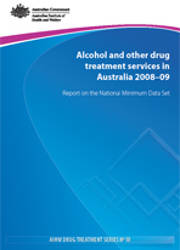Summary
This report presents the findings of the 2008–09 Alcohol and Other Drug Treatment Services National Minimum Data Set (AODTS–NMDS). It is the ninth in a series of annual publications focusing on clients of government-funded alcohol and other drug treatment services. In particular, it highlights the drugs that clients are concerned about and the types of treatment they receive. This report also presents contextual information about drug use, drug-related deaths and hospital stays and other treatment provided for alcohol and other drug issues across Australia.
Clients
Around 143,000 treatment episodes were reported during 2008–09, a decrease of about 10,000 episodes compared with 2007–08. A data submission gap from an area of New South Wales due to information systems issues accounts for approximately half of this reported decline. The vast majority of treatment episodes (96%) were for clients seeking treatment for their own drug use. The largest group of clients was males aged 20–29 years. This finding has been consistent over time. Younger clients were more likely to receive treatment for cannabis use and older clients for alcohol use.
Drugs
Alcohol remains the most common principal drug of concern, increasing over time to 46% of all treatment episodes in 2008–09 compared with 38% in 2002–03. Treatment for heroin use has been declining over time to 10% in 2008–09 compared with 18% in 2002–03; also the actual number of episodes for the treatment of heroin use has declined. Treatment for cannabis use has remained stable at about 22% while amphetamine treatment as a proportion of all episodes has declined from 11% in 2007–08 to 9% in 2008–09.
Treatment
Over a third of episodes commenced following self-referral. Counselling remained the most common treatment provided at about 2 in 5 episodes. The proportion of clients in withdrawal management (detoxification) has declined since 2002–03, even though the number of these episodes has increased overall.
Changes over time
In 2008–09, fewer treatment episodes were reported from fewer treatment agencies compared with the previous year. The decline in the number of agencies reporting is mostly due to an information system issue in one New South Wales area, however, a number of other jurisdictions also reported declines in the number of episodes provided to clients in 2008–09. A multitude of factors may potentially contribute to changes in the pattern of drugs for which treatment is sought over time. These factors include but are not limited to changes in the drug market, the perception of use by drug users and the community, the availability of treatment services and willingness to seek treatment.



